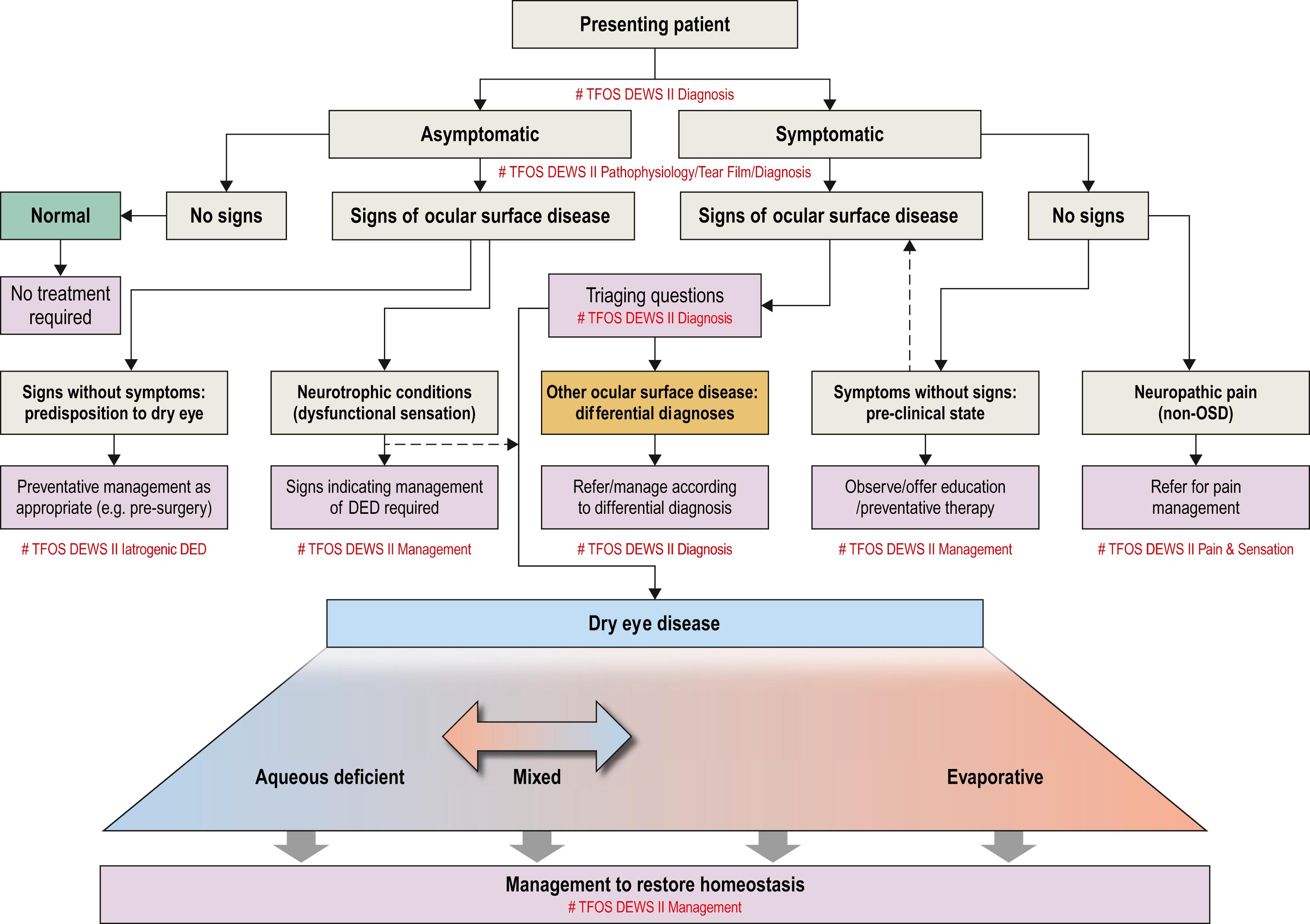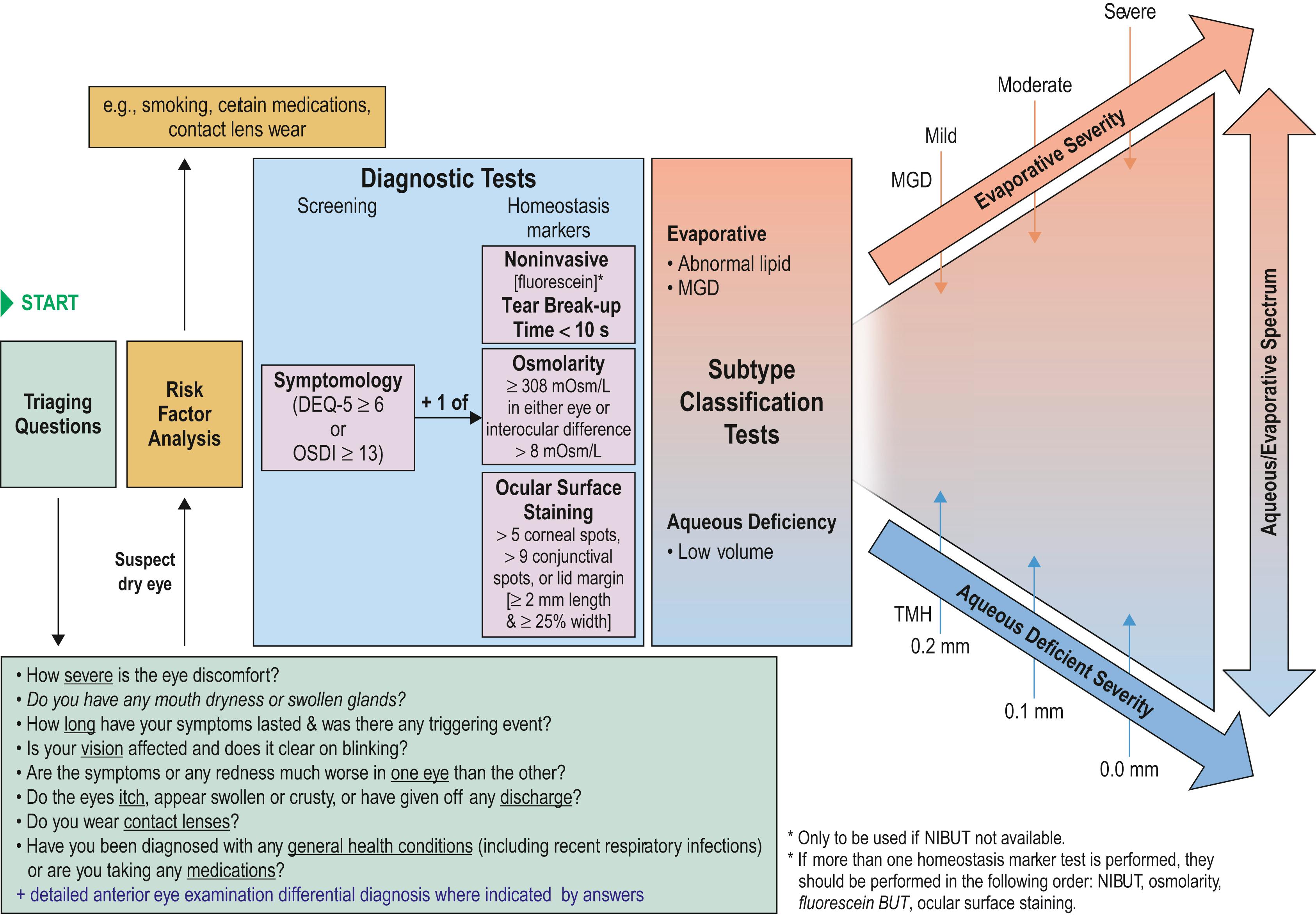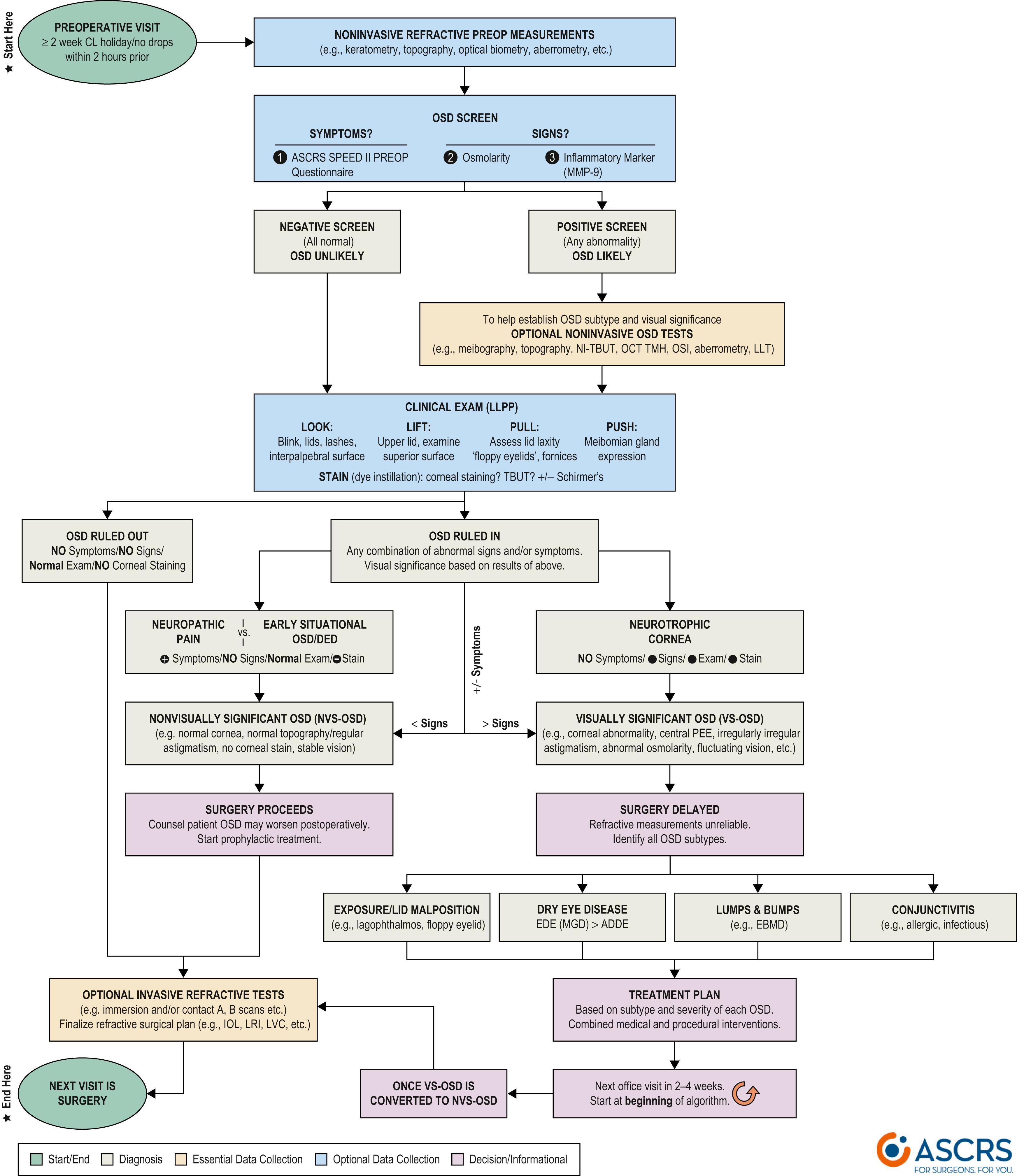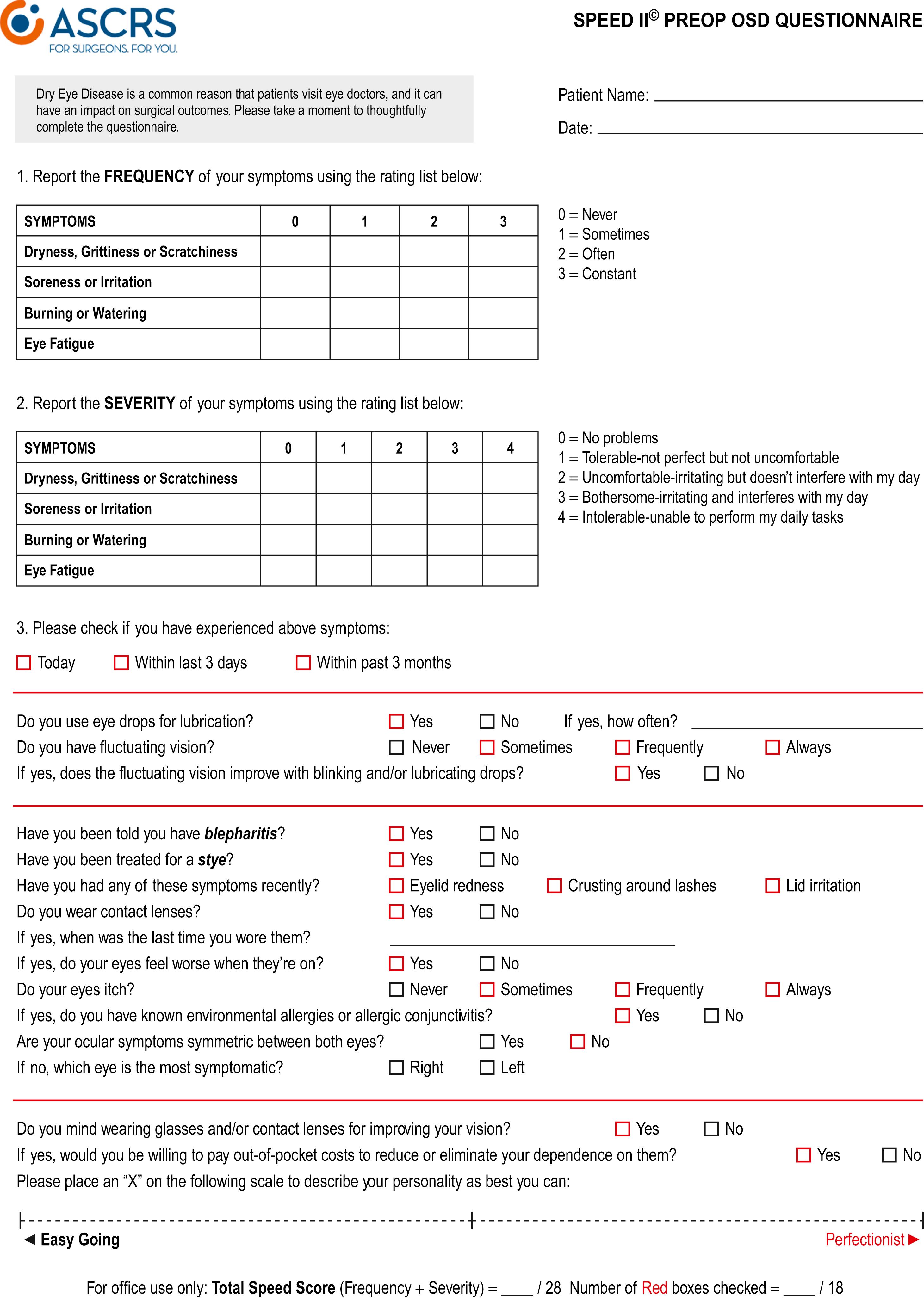Physical Address
304 North Cardinal St.
Dorchester Center, MA 02124
Although dry eye disease is clinically classified as primarily aqueous-deficient versus evaporative, there is significant overlap of these and other subtypes of ocular surface disease, often leading to poor correlation between signs and symptoms.
Subjective dry eye symptoms including burning, itching, foreign body sensation, visual fluctuations, and dryness have shown poor correlation with objective tests for dry eye disease.
Treatment algorithms need not be followed linearly but should take into consideration primary dry eye disease subtype, cost of proposed treatment, and risk versus benefit specific to each patient.
Dry eye disease (DED) is one of the most common presenting ocular conditions to all eye care providers. An update to the original Tear Film and Ocular Surface Society (TFOS) Dry Eye Workshop (TFOS DEWS II) was published in 2017 and included a revised definition of this complex disease. The TFOS DEWS II report defined dry eye as the following:
Dry eye is a multifactorial disease of the ocular surface characterized by a loss of homeostasis of the tear film, and accompanied by ocular symptoms, in which tear film instability and hyperosmolarity, ocular surface inflammation and damage, and neurosensory abnormalities play etiological roles.
The key point of this updated definition is that loss of homeostasis of the tear film, due to any number of factors, is the final common pathway of this disease. A meta-analysis of published data demonstrated that the prevalence of DED ranged from 5% to 50% across studies. Prevalence increased with age and female sex, although there was poor study representation in younger people and in those living south of the equator (DEWS II epi plus 3). , Thus DED should be considered a significant public health problem that will have a considerable economic impact through both direct costs to health care and indirect costs including loss of work hours. ,
Despite the efforts of the TFOS DEWS II and other DED research, many clinicians continue to harbor misconceptions about its pathology and presentation. Common misconceptions outlined in a review by Bron et al. include that: (1) DED is synonymous with the aqueous-deficient subtype (ADDE); (2) DED is a symptom-driven disease; (3) there are no significant visual sequelae with DED; (4) variability in objective signs and symptoms imposes problems for clinical practice and research; and (5) DED is simply a part of the burden of old age. Significant research efforts covered in this chapter have dispelled the above misconceptions and have allowed clinicians to better diagnose and treat this complex and multifactorial disease. Therefore a complete discussion of DED pathophysiology, diagnosis, and treatment will be presented in this chapter with the goal of promoting informed and advanced clinical management.
Maintaining a healthy and comfortable ocular surface requires stability and renewal of the tear film. DED is a multifactorial disorder, and alterations in the volume, composition, distribution, and/or clearance of the tear film can lead to ocular surface dysfunction and DED. Loss of homeostasis of the tear film and resulting ocular surface inflammation is the common final pathway for all causes of DED. Two mutually reinforcing global mechanisms, tear hyperosmolarity and tear film instability, have been identified. Classically, the tear film was considered to have three major layers: mucous, aqueous, and lipid. However, current opinion is that the layers are interactive and exist instead as a two-phase model, comprising of a lipid layer overlying a mixed muco-aqueous layer. A stable precorneal tear film is an essential component of the health of the ocular surface and for maintaining high quality vision. ,
Evaporation-induced tear hyperosmolarity is regarded as the central mechanism that leads to ocular surface inflammation, and resultant ocular surface damage, which in itself leads to more inflammation, termed the Vicious Circle of Inflammation. It can arise from reduced lacrimal secretion, excessive tear film evaporation, or a combination thereof. Hyperosmolar tears can damage the ocular surface epithelium by activating an inflammatory cascade in the surface epithelial cells, causing the release of inflammatory mediators, cytokines (e.g., interleukin [IL]-1α, IL-1β, tumor necrosis factor [TNF]-α), and matrix metalloproteinases (MMPs). , Regardless of the underlying etiology, inflammation is the core process perpetuating the DED state.
DED was classically divided into two major subtypes: aqueous deficiency dry eye (ADDE) and evaporative dry eye (EDE). However, recent evidence demonstrates that these are not mutually exclusive and in actuality exist on a continuum, with many patients exhibiting evidence of both ADDE and EDE. Additionally, both subtypes result in the same final common pathway of dysfunctional tear syndrome: hyperosmolarity, inflammation, and tear film instability. The TFOS DEWS II classification schema simplifies the differential diagnosis based on the various combinations of signs and symptoms, thereby helping direct clinical management ( Fig. 31.1 ). Patients may be asymptomatic but exhibit signs of DED and may benefit from preventative therapies, especially before planned ocular surgery. Neurotrophic conditions should also be considered in those with signs but no symptoms, as sensory block can diminish reflex-induced lacrimal secretion, blink rate, and lead to increased evaporative loss. This can be seen in patients affected by diabetes, herpes simplex or zoster ophthalmicus, after laser vision correction surgery (laser in situ keratomileusis [LASIK], photorefractive keratectomy [PRK], small-incision lenticule extraction [SMILE]) and limbal relaxing incisions (LRI), and other diseases that may affect the trigeminal nerve. Patients who experience symptoms without signs may be in a preclinical state of DED or may be suffering from neuropathic pain syndrome (“pain without stain”) and would benefit from pain specific management strategies. Lastly, DED should be differentiated from of other forms of ocular surface disease (OSD) that may cause DED-like symptoms but require different treatment.

Once DED has been determined, the classification schema then outlines the etiologic classification and the main subtypes of DED: ADDE and EDE. All DED exists on a spectrum with features of both subtypes, but with EDE and/or hybrid DED as the most prevalent forms. Clinically, it is important to determine the predominant etiology, as efficacy of available treatments may differ based on subtype.
ADDE defines diseases of lacrimal function and has two major subclasses: Sjögren syndrome dry eye (SSDE) and non-Sjögren syndrome dry eye (NSDE).
Sjögren syndrome (SS) is an exocrinopathy in which the lacrimal and salivary glands, as well as other organs, are targeted by an autoimmune process. The glands are progressively infiltrated by activated T-cells, which ultimately cause acinar and ductal epithelial cell death and hyposecretion of the tears or saliva. There are two forms of SS : “primary SS” refers to cases where there is no other associated systemic connective tissue disease, and “secondary SS” consists of the features of primary SS together with the features of another overt autoimmune disease, most commonly rheumatoid arthritis.
NSDE is a form of ADDE due to lacrimal dysfunction, where the systemic autoimmune features of SSDE have been excluded. The most common form is age-related dry eye (ARDE) due to increases in ductal pathology with age. , Yet another contributing factor to these age-related symptoms may be changes in sex hormone levels, specifically a physiologic decrease in androgens and/or an increase in estrogen. ,
Rarely, the lacrimal gland may be absent or hypoplastic (familiary dysautonomia), or innervation of the gland may be abnormal.
Secondary causes of lacrimal gland dysfunction can also lead to ADDE . Lacrimal secretion may fail because of infiltration of the gland (sarcoid granulomata, systemic viral infections, lymphoma, amyloidosis) or cicatrization of the ducts of the main and accessory lacrimal glands (trachoma, mucus membrane pemphigoid, Stevens-Johnson syndrome, chemical/thermal injury). Patients with graft-versus-host disease (GVHD) also demonstrate decreased tear turnover due to a combination of lacrimal gland damage and meibomian gland destruction.
Lastly, reflex motor block and ADDE are associated with systemic drug use, particularly those with anticholinergic effects (antihistamines, β-blockers, antispasmodics, diuretics, tricyclic antidepressants, and selective serotonin reuptake inhibitors).
Excessive evaporation from the ocular surface is the hallmark of EDE and is most commonly due to meibomian gland dysfunction (MGD). MGD is a condition characterized by obstructed meibomian glands that leads to the aforementioned hyperevaporation, hyperosmolarity, and inflammation of DED. There is a normal decline in meibomian gland function with age, which is thought to be secondary to a decline in androgen levels (sex and hormones). , However, there are a number of conditions that may further hamper the production and release of meibum. MGD and the resultant low flow of meibum to the ocular surface may be due to cicatricial or non-cicatricial causes. In non-cicatricial MGD, hyperkeratinization of the terminal ducts, late obliteration of the gland orifices, and inflammatory mediators at the lid margins are key features and are associated with certain skin conditions including acne rosacea and seborrheic dermatitis. In cicatricial MGD, conjunctival scarring is responsible for displacement of the ducts and the inability to deliver meibum to the ocular surface. Such conditions may include trachoma, erythema multiforme, and pemphigoid.
Secondary causes of MGD include local effects (e.g., contact lens wear, anterior blepharitis), systemic conditions (e.g., rosacea, atopic or seborrheic keratitis), or chemical exposure (e.g., 13-cis retinoic acid, polychlorinated biphenols found in topical glaucoma agents). Lastly, lid aperture and other OSD states may also lead to MGD and ensuing EDE.
The main objective in the management of DED is the return to homeostasis of the ocular surface, thereby improving quality of life for patients. The diagnosis and management can be complex due to the multifactorial nature of this disease, and therefore clinicians will benefit from determining the primary underlying causes of the patient’s symptoms. The predominant published treatment algorithms can be easily incorporated by most practices and followed linearly or alternatively, can be modified based on the particular practitioner and office workflow and resources.
This algorithm was established to help eye care professionals identify DED in general nonsurgical patients. It includes triaging questions for identifying risk or suspicion of DED and/or other forms of OSD that may be masquerading as DED. If high suspicion for DED is present, then the diagnostic DED algorithm is initiated with a validated questionnaire (DEQ 5 or OSDI) and objective tests (tear break-up time [TBUT] [noninvasive preferred, or fluorescein TBUT], osmolarity, and staining). If the patient has abnormal symptom scores plus one abnormal objective test, then they are deemed to have DED. Then, the clinical exam (with or without ancillary optional objective measurements) identifies subtypes and severity of DED which guides treatment options.

It is well-established that the ocular surface is an important consideration in cataract and refractive surgery outcomes, as it can affect the preoperative measurements and postoperative refractive outcomes and patient satisfaction. , The American Society of Cataract and Refractive Surgery (ASCRS) algorithm was established to diagnose any visually significant OSD (VS-OSD), not just DED. The algorithm is designed to be incorporated into the standard preoperative visit and workup. The initial OSD screening battery consists of the ASCRS SPEED II Questionnaire ( Fig. 31.4 ), tear osmolarity, and MMP-9. The inclusion of inflammation testing (MMP-9) helps to identify other subtypes of OSD, especially when osmolarity is normal. When VS-OSD is identified via symptoms, signs, objective testing, and/or the “ look, lift, pull, push ” clinical exam (look at the lids and lashes; lift the upper eyelid and examine the surface; pull to assess lid laxity; push for meibomian gland expression), surgery is postponed and treatment recommendations are initiated. Treatment for presurgical patients is typically more multifaceted and aggressive than those for nonsurgical patients in order to minimize surgical delays and to reduce the risk of surgical complications and unsatisfactory visual outcomes.


Treatment regimens are customized for each patient based on the outcomes of the diagnostic algorithms, which identify the subtype of DED and/or other forms of OSD and their severity. Treatment recommendations should consider healthcare costs, risks versus benefits, and individual clinical scenarios (e.g., preoperative versus nonsurgical). General recommendations by TFOS DEWS II for staged management suggest starting at Step 1 with low risk, low cost options and progressing to more advanced therapies as needed. Discussion on the various therapies available follows.
Become a Clinical Tree membership for Full access and enjoy Unlimited articles
If you are a member. Log in here